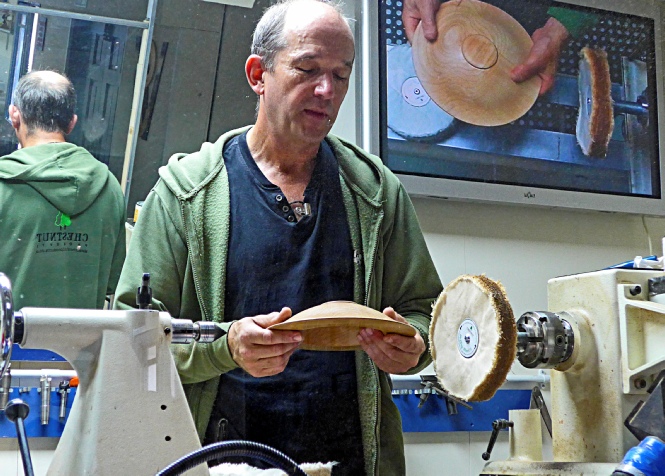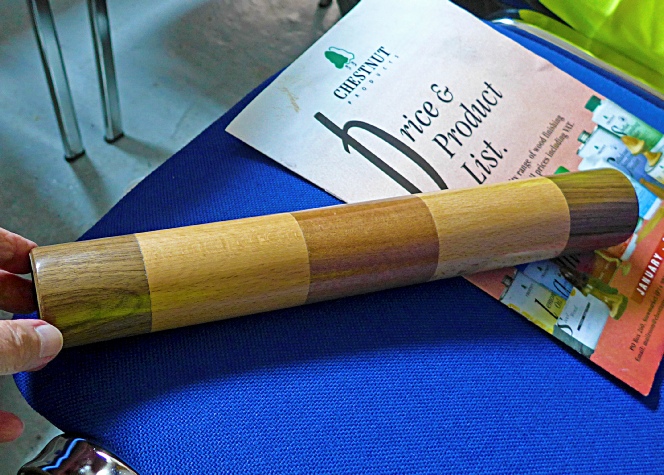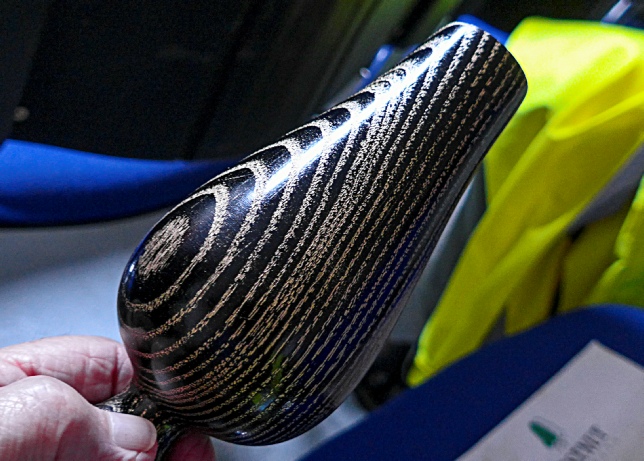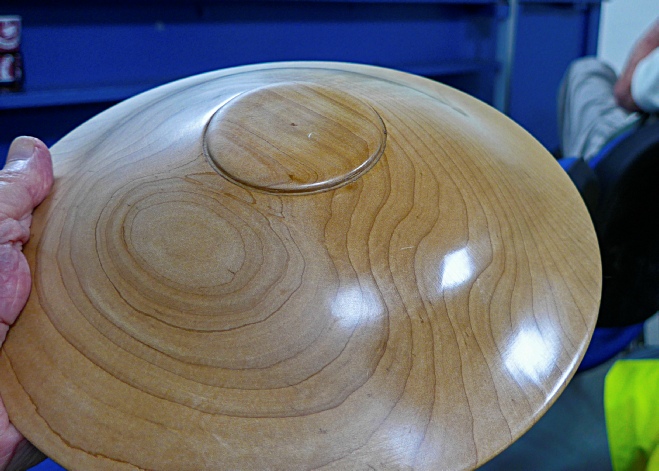


Notes from the Demonstration about Chestnut products:
Website: www.chestnutproducts.co.uk
Terry Smart, the owner of 'Chestnut Products' gave an informative presentation and demonstration of how to use different finishing products. When sanding prior to applying any of the finishing products he recommended using the fine grids included in the Nyweb abrasives and to employ tack cloths to remove tiny dust particles. He emphasised that in his opinion the finishing process should be carried out as a pleasant experience without undue pressure. This has been one of the objectives aimed at when producing the finishing products.
Nyweb abrasivesare available in packs of 4: green 400 grid, Red 800 (or 600?), orange 1000, and white very fine without abrasive.
Tack cloth, should be kept in an airtight jar to prevent it drying and hence prolong usability.
Sanding sealers and Lacquers. Three types offered are based on Cellulose, Acrylic and Shellac, the first 2 available in liquid and spray form .
Cellulose sanding sealers ought not to be thinned as is often done. The reason being that when the sealer is thinned it may penetrate the woods to such an extend that the particles in the sealer do not give sufficient coating on the surface thus preventing a smooth surface when using fine abrasives prior to adding lacquer or wax. To get a really fine surface after having applied sanding sealer use the Nyweb abrasives mentioned above.
The Acrylic based products are similar to cellulose but take slightly longer to dry.
Cellulose lacquers , including Melamine lacquers and Ebonising Lacquer, should not be applied on top of acrylic sealers as the cellulose may affect and react with the acrylic. The difference between cellulose lacquer and Melamine is that Melamine is pre-
After applying lacquer use Burnishing cream to get a gloss finish. Chestnut's Burnishing cream is milder than T-
A good tip when using any form of surface finish is to wipe the thread on the bottle after each use, which will make it easier to open the lid next time.
Shellack sanding sealer which takes longer to dry than cellulose and acrylic is an ideal base for Friction Polish, which can be polished to a high gloss. It is not as durable as acrylic and cellulose lacquers.
Woodwax 22 is suitable to be applied directly on top of sanding sealer as Terry demonstrated (see 2nd photo). As it is quick drying it may be polished almost as soon as it has been applied. This, however is not the case with Microcrystaline which needs some 20 minutes to dry before it is polished.
One advantage of Microcrystaline wax over Woodwax 22 is that it is more resistant to water and won't be marked by frequent handling. The Woodwax is a durable finish but may be affected by moisture when handled. If more then one coat of wax is needed only 3 coats should be used as otherwise the surface nay be too soft. It should be mentioned that with Microcrystaline wax only very thin coats are needed.
Other waxes offered contain Carnuba wax, either neat Carnuba which is hard and brittle, or blends containing Bees Wax available in stick form. The latter being softer and less likely to scratch the wood when used and therefore more suitable than pure Carnuba on softer woods. Other waxes like liming wax, are described in Chestnut's website.
Oils. 5 different oils are marketed by Chestnut: Finishing Oil, Food Safe Finish, Tung Oil, Hard Wax Oil, and Lemon Oil.
Finishing oil contains Tung oil and produces a tough, water resisting finish. A high gloss finish can be achieved with several coats. It can take up to 10 hours to harden.
Food Safe Finish is a thin oil that dries to a satin finish after about 2 hrs and which will withstand wiping with a damp cloth.
Tung oil is a natural oil which produces a hard wearing heat and water resistant finish. It dries overnight.
Hard wax oil contains wax and produces a hard wearing finish. Although suitable for toys it is not food safe and should not be used on items that are likely to come into contact with food, again a gloss finish can be achieved after several coats, with drying times approximately 4 hours.
Lemon oil is a clear thin pleasant smelling oil which leaves a matt surface and takes up 24 hours to fully dry.
One attractive finish on Ash was shown (see 3rd photo) where the wood after sanding was brushed with a mild brass brush to open the grains slightly. It was then sprayed with several very light coats of Ebonizing lacquer and burnished. Once dry a thin coating of gilt cream was applied and wiped off to allow just the gilt cream left in the pores of the wood to remain. The surface was finally wiped with a thin coat of food safe (or other thin) oil to remove traces of gilt cream on the surface. This -
Finally, Terry demonstrated his polishing system using 3 grades of 8 inch polishing mops (Photos 1 & 4). Initially the coarsest wheel, A, was dressed with brown rubbing compound (Triplet) running at 1200 rpm. The second wheel, B, was dressed with a white compound. The finishing wheel, C, was dressed with a small amount of Carnuba wax. As the mop was very flexible awkward areas could be reached by reducing the speed and using the side of the wheel which would flex to get into difficult areas to reach. Special dome shaped mops are also available.
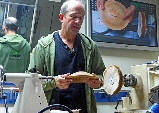
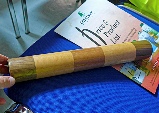
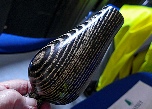
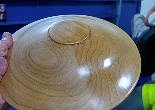
Terry Smart
11 June 2016
| Club Details |
| shop |
| Grassroots Grant |
| valuation |
| Andrew Coe Dec. '11 |
| Andrew Coe & Bill Care |
| more Andrew Hall |
| Bill 90 |
| Joey's demo notes |
| December 2010/11 |
| Mike's 2nd page |
| 2011 & 2013 |
| 2014 & 2015 |
| More Simon |
| Coffee Table |
| Gallery 2 |
| Gallery 3 |
| Gallery 4 |
| Gallery 5 |
| Gallery 6 |
| Xmas dinner 2009 |
| Archive |
| Blackwater 2010 |
| Blackwater 2012 |
| Fakenham Show |
| Blackwater 2014 |
